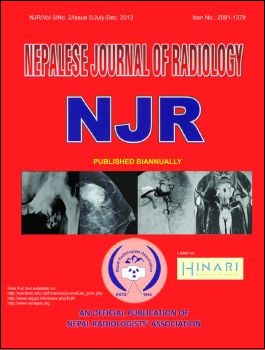Blunt Splenic Injury: Efficacy of Superselective Splenic Artery Embolization
DOI:
https://doi.org/10.3126/njr.v3i2.9606Keywords:
Embolization, Nonsurgical management, Splenic angiography, Splenic injury, Splenic lacerationAbstract
Objective: To evaluate the efficacy of superselective splenic artery embolization (SAE) using a coaxial catheter technique in patients with blunt splenic injury.
Patient Selection and Methods: We retrospectively reviewed cases of 24 consecutive patients undergoing splenic angiography for blunt splenic injury at a Level 1 trauma center. After angiographic confirmation of splenic injury, superselective SAE was performed using gelfoam pledgets (n=15), with or without coils, and liquid embolic materials (n=9). All procedures were performed through a microcatheter advanced coaxially through a selective angiographic catheter. Severity of splenic injury was graded using CT imaging. The angiographic findings were retrospectively divided into four groups. Outcome measures included technical success, complications and recurrence of symptoms requiring additional intervention or surgery despite embolization.
Results: All cases were technically successful, with immediate occlusion of targeted vessels after embolization. One patient underwent distal pancreatectomy- splenectomy 3 days after splenic embolization due to symptoms related to distal pancreatic injury, unrelated to the angiographic intervention. A second embolization was performed 1-3 days after initial embolization in 4 patients with clinical suspicion of re-bleeding. One of these four patients underwent splenectomy 3 days after the second embolization, during exploration for associated bowel and diaphragmatic injury. A second patient underwent splenectomy 1 day after a second embolization due to need for continued transfusions. The splenic salvage rate was not significantly related to CT grade of splenic injury (p=1.0) or angiographic classification (p=0.8).
Conclusion: Superselective SAE can be performed as a safe alternative to splenectomy in patients with blunt splenic trauma, particularly when there is no additional major organ injury.
DOI: http://dx.doi.org/10.3126/njr.v3i2.9606
Nepalese Journal of Radiology Vol.3(2)July-Dec, 2013: 37-48
Downloads
Downloads
Published
How to Cite
Issue
Section
License
This license enables reusers to distribute, remix, adapt, and build upon the material in any medium or format, so long as attribution is given to the creator. The license allows for commercial use.




